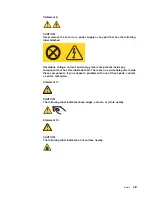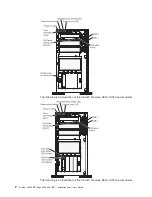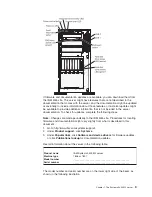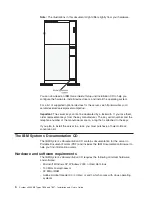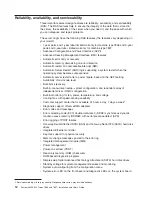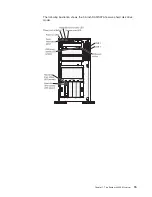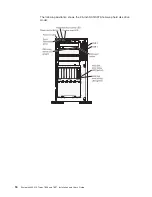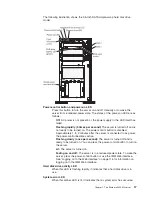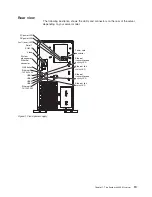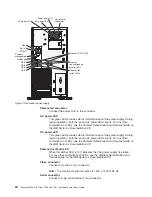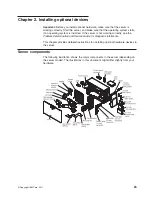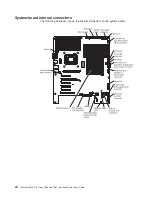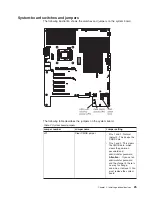
hard disk drives (depending on the model). With the hot-swap feature, you can
add, remove, or replace hard disk drives without turning off the server.
v
Large system-memory capacity
The server supports up to 96 GB (reduced to 48 GB in mirroring mode) of
system memory. The memory controller supports error correcting code (ECC) for
up to 12 industry-standard PC3-10600R-999 (single-rank or dual-rank), 800,
1067, and 1333 MHz, DDR3 (third-generation double-data-rate), registered,
synchronous dynamic random access memory (SDRAM) dual inline memory
modules (DIMMs).
v
Memory mirroring
Some models support memory mirroring. Memory mirroring replicates and stores
data on two pairs of DIMMs within two channels (channel 0 and 1)
simultaneously. If a failure occurs, the memory controller switches from the
primary pair of memory DIMMs to the backup pair of DIMMs. To support memory
mirroring, you must install a pair of DIMMs at a time. One DIMM must be in
channel 0, and the mirroring DIMM must be in the same slot in channel 1. For
more information, see memory mirroring on page 47.
v
ServeRAID support
The ServeRAID adapter provides hardware redundant array of independent disks
(RAID) support to create configurations. The standard RAID adapter provides
RAID levels 0, 1, and 1E. The optional RAID adapters are available for purchase
and provide RAID levels 0, 1, 5, 6, 10, 50, and 60. See “Installing an adapter” on
page 70 and “Using LSI Configuration Utility program” on page 117 for more
information about the adapters that are supported and creating RAID arrays.
v
Symmetric multiprocessing (SMP)
The server supports up to two Intel Xeon microprocessors. Each microprocessor
provides symmetric multiprocessing capability. When you install the second
microprocessor, this will enhance the performance of the server.
v
Systems-management capabilities
The server comes with an integrated management module (IMM). When the IMM
is used with the systems-management software that comes with the server, you
can manage the functions of the server locally and remotely. The IMM also
provides system monitoring, event recording, and network alert capability. The
systems-management connector on the rear of the server is dedicated to the
IMM. The dedicated systems-management connector provides additional security
by physically separating the management network traffic from the production
network. You can use the Setup utility to configure the server to use a dedicated
systems-management network or a shared network.
v
TCP/IP offload engine (TOE) support
The Ethernet controller in the server supports TOE, which is a technology that
offloads the TCP/IP flow from the microprocessor and I/O subsystem to increase
the speed of the TCP/IP flow. When an operating system that supports TOE is
running on the server and TOE is enabled, the server supports TOE operation.
See the operating-system documentation for information about enabling TOE.
The Windows operating system requires that the Windows Scalable Network
Pack (SNP) be installed for TOE support.
Note:
As of the date of this document, the Linux operating system does not
support TOE.
Chapter 1. The System x3400 M2 server
11
Summary of Contents for 783722U
Page 1: ...System x3400 M2 Types 7836 and 7837 Installation and User s Guide...
Page 2: ......
Page 3: ...System x3400 M2 Types 7836 and 7837 Installation and User s Guide...
Page 8: ...vi System x3400 M2 Types 7836 and 7837 Installation and User s Guide...
Page 18: ...xvi System x3400 M2 Types 7836 and 7837 Installation and User s Guide...
Page 57: ...Chapter 2 Installing optional devices 39...
Page 122: ...104 System x3400 M2 Types 7836 and 7837 Installation and User s Guide...
Page 153: ......
Page 154: ...Part Number 69Y4170 Printed in USA 1P P N 69Y4170...

